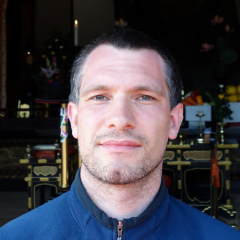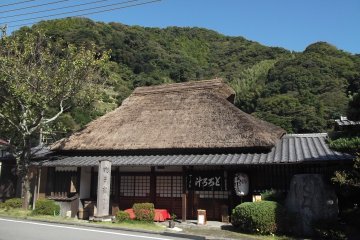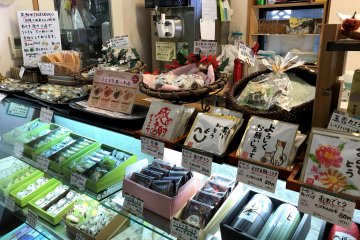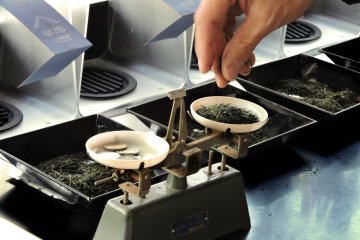Izumigaya Craft Inn Waraku (hereinafter Waraku) offers authentic stays at its one-of-a-kind villas that will delight art and crafts enthusiasts, honeymooners, discerning families, and business teams yearning for an intimate and exclusive atmosphere. Located off-the-beaten-track in Shizuoka—one of Mount Fuji’s prefectures and the tea capital of Japan—these sustainable historic buildings are a quick shinkansen ride from Tokyo or Nagoya. For optimal relaxation and privacy, book your preferred vacation villa early for 3+ weekdays.
Vacation at a Village of Villas
Unlike usual hotels and ryokans, Waraku is akin to a charming village in a forested mountain. Each “corridor” is a cute alley with its own quirks (e.g. onigawara roof ornamentation), and each “room” is a unique private masterpiece of Japanese architecture and design. Waraku caters to every need—from the Kura villa’s cosy honeymoon vibes to the Fuji villa’s spacious setup for family or friends to the complete set of villas for small-scale private corporate retreats or MICE stays. Far from the city centre, it is particularly peaceful and relaxing on weekdays and enjoyable even on rainy days!


In these villas, traditional elegance shines. Some highlights include beams of aged wood, subdued earthy tones accented by discreet lighting, long baths of fragrant hinoki (native cypress), handcrafted wooden furniture, mesmerising bamboo lattice artworks, and paper-based shoji windows bestowing both privacy and natural light. Modern comfort is also harmoniously blended into the accommodations: Wi-Fi, heated flooring, quiet air conditioning and purifier, washlet, non-slip bathroom flooring, bathtub water temperature maintainer, sauna with soothing tea-infused water for the hot stones, and a vanity desk with concealed lighted mirror.





Which countryside villa would you prefer to unwind alone or in good company?
-
Kura, a renovated traditional storehouse, is perfect for architecture lovers and honeymooners with its king-size bed, 60㎡, and expansive garden view through larger-than-life windows.
-
For separate beds, friends and siblings would favour the Doma villa (61㎡) with its landscaped garden and extensive araidashi floor (washed-out concrete with small pebbles), or the Wa villa for its veranda and extra 10㎡.
-
The Raku villa (87㎡) best suits couples of friends or parents with 1-2 teenagers who’d enjoy its L-shaped sofa and seasonally charming garden.
-
Travellers more comfortable in smaller spaces (16-28㎡) may enjoy Ichihime’s veranda overlooking a serene pond, Ichiro’s wood deck with cosy chairs to gaze at the clouds and moon, or Ichie’s tranquil feel of an era with simpler lifestyles connected to nature rather than cyberspace.
-
Finally, the Fuji villa welcomes up to six guests with its 129㎡, garden-facing veranda, sauna for six, extra-large hot bath (+ two cold plunges), washing machine, and spacious kitchen ideal for lively chats with good drinks.


Note: The most cane-friendly villa is Doma, followed by Wa, both with a single floor and just one step here and there.
Discover Authentic & Sustainable Luxury
Every villa of 170 y.o. Waraku is a testament to regenerative business and sustainable living. The architects, artisans, and construction workers saved and lovingly renovated these old kominka (Japanese traditional houses), incorporating seismic protection and heat insulation while preserving their charm and cultural heritage. Each villa tells a different story of the ancient Tokaido road. Design Office Sozosya and its staff’s commitment to environmental responsibility is unmistakable in the concept, and includes the preservation of streams and trees, sourcing of local materials and renewable energy, reuse of antiques and parts of other buildings, adoption of diverse eco-friendly practices, and creation of rural jobs.




The final touches of all the private villas are imbued with a sustainable and responsible ethos. Befitting the forested landscapes and traditional architectures, the wooden toothbrushes, razors and hairbrushes are elegant and comfortable. The bamboo lattice containers, lightweight cups and other high-quality items crafted by local artisans showcase Shizuoka’s craftsmanship. And to enhance your stay, Waraku’s staff curated a selection of local delights including signature teas, craft beers, ice creams, and other seasonal specialties.



Finally, nature strongly influenced the choice of the locations, architectural enhancements and interior designs as exemplified by the following:
-
To make deck chairs more relaxing on sunny summer days, the facility added climbing vines on pillars to ultimately create a refreshing green canopy beneath a villa’s transparent roof.
-
On sunny mornings in the bedroom of the Wa and Raku villas, you may find yourself soothed by gentle shadows of vegetation filtering through the paper windows.
-
If you open the aforementioned windows of the Wa villa, you’ll notice how Japanese workers painstakingly incorporated branches in the fencing instead of cutting them.
-
Upon arriving at the Japanese restaurant Wakamatsu for breakfast, you’ll undoubtedly sit facing the expansive window framing a forested mountain and hopefully blue sky while drinking your coffee or tea.


Savour Ephemeral and Traditional Cuisine
Waraku’s unique culinary offerings are on a par with its accommodations. A complete plan will take you to the neighbouring Simples and Wakamatsu restaurants, which showcase the finest ingredients of Shizuoka’s mountains and seas, innovative and local recipes, and Japanese hospitality. From unforgettable fine dining featured in the Gault & Millau food and wine guide to casual breakfasts, each meal is a delightful gastronomic adventure.
Renowned for his minimalist approach, Simples’ chef Yasuhiko Inoue sources the day’s best harvest and seafood from Suruga Bay and expertly showcases the intrinsic flavours of each ingredient. His refined seasonal dishes captivate gourmets who cherish flavours available only here and now. His elegant 12-course dinners pairing food with carefully selected local saké and international wines reflect his culinary journey through Japan, Belgium, France, and Italy. Beyond the food, discerning diners and architecture enthusiasts will love the one-of-a-kind modern building and its intimate atmosphere.




With gentle sun enlivening a full set of Hokusai’s 36 Views Of Mount Fuji ukiyo-e illustrations and with the bilingual hostess Naomi’s friendly greetings, Japanese restaurant Wakamatsu is ideal to joyfully start the day. Its healthy and energising Japanese breakfast features various fresh local produce and seafood. Gourmets exploring regional cuisines should mindfully taste two traditional delicacies:
-
Mariko-juku tororo-jiru, a creamy vegan dish of grated wild yam distinctively flavoured by the local alkali-basalt soil, popular with samurai and other travellers since the Edo period.
-
Shizuoka oden, a traditional one-pot dish warmed over a flame. This regional oden characteristically features skewered ingredients and dark-coloured broth flavoured with beef stock and dark soy sauce.


Shizuoka Crafts and Japanese Artworks
The high-end bamboo lamps in the villas and bamboo lattice domes of cake sets at The Coffee Roaster nearby café are fascinating. They are products of Suruga Take-sensuji-zaiku, a prized traditional craft from Waraku’s district (Suruga) famous nationwide. To deepen your understanding of this cultural heritage, your villa booking includes a coupon for a premier hands-on workshop about bamboo lattice ware found only in Shizuoka. Under the guidance of a Japanese artisan at the nearby Takumishuku traditional handcraft arts and experiences centre, you can learn techniques passed down through generations and create your own personalised artwork. Wouldn’t you enjoy weaving delicate bamboo strips into a practical storage container, graceful flower vase, or soothing wind chime to bring home and use in your daily life?


Reflecting Shizuoka’s strong artisanal tradition initiated by shogun Tokugawa Iemitsu four centuries ago, Takumishuku also lets you create lasting memories with artisans through eco-friendly activities such as Shizuoka’s subtle tea dyeing (instead of vibrant indigo), Japan’s renowned nailless woodworking, delicate lacquering, and intricate pottery. There is also a more modern workshop in collaboration with world-famous architect Kengo Kuma that lets you build a uniquely-yours stool. To discover more one-of-a-kind pieces by local craftspeople, head to Teto Teto gallery and lifestyle store.

Waraku takes you on a charming journey of authentic slow tourism with sustainable lodging. For personalised experiences, including special dietary accommodations, art tours, or behind-the-scenes renovation tours guided by Shizuoka residents, such as artist Corey Turpin or architect Miroslav Bachura, contact Japan Travel’s travel agency in English, French, German, Italian, or Spanish.
Getting There
From Tokyo, Nagoya, Kyoto, or Osaka, you can ride a shinkansen to Shizuoka station (1-2 hours, 6,300-11,000 yen). Then use the North Exit. From Haneda Airport, ride a comfortable direct bus with toilets instead (4 hours, 3,200 yen). From Shizuoka station, Waraku’s front office is a roughly 20-minute taxi ride (3,000 yen).
From Mount Fuji Shizuoka Airport, the simplest route is to ride a taxi directly to Waraku (50 minutes, 11,500 yen). Flights to this airport come from Asia (Hangzhou, Seoul, Shanghai, Taipei) and Japan (Fukuoka, Izumo, Kagoshima, Kumamoto, Naha, Sapporo).

































